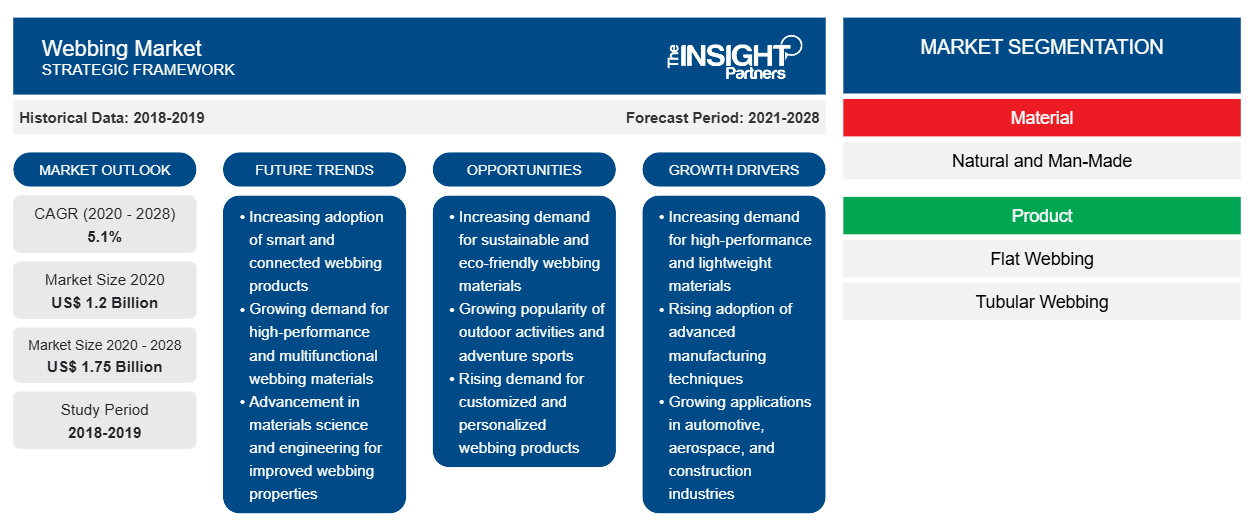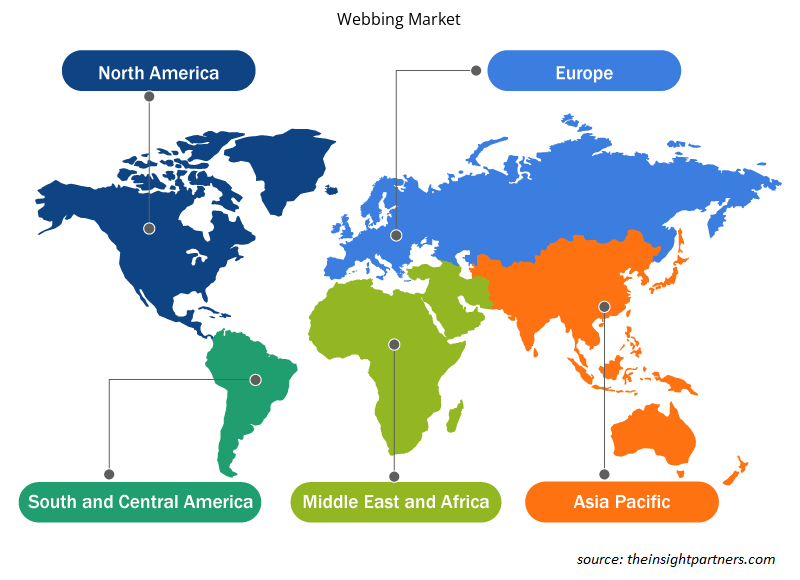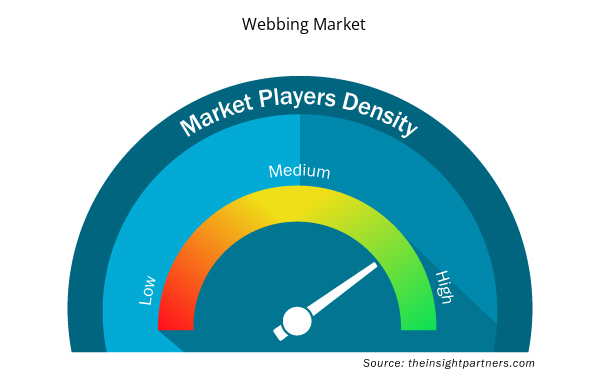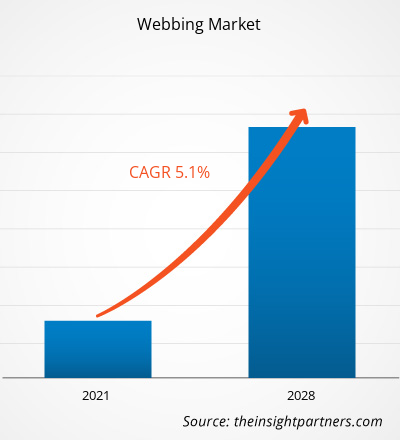The webbing market is projected to reach US$ 1745.84 million by 2028 from US$ 1,195.35 million in 2020; it is expected to grow at a CAGR of 5.1% from 2021 to 2028.
Webbing is a strong woven fiber available in flat strips or tube form; it is used as a substitute of rope. Conventionally, webbing is produced using cotton and silk, however, polymer, nylon, and polyester are replacing the traditional materials. Webbing is known for its properties such as convenience, tensile strength, and chemical resistance; it can be used as a replacement of steel wires, ropes, or chains in various industrial applications. Webbings are significantly used in military apparels, parachutes, climbing, automotive textile, fire safety gear, military goods, harnesses, packs, hiking gear, and others. Other than this, webbing is extensively used to produce protective equipment for oil & gas workers.
The automotive segment would hold the largest share of the global webbing market, by end use, in 2021. Webbing is a significant component of manufacturing of seat belts, safety harnesses, pull straps; edge binding for convertible tops; straps and binding for luggage nets; catch belts for airbags; and so on. Rise in demand for vehicles in developing economies such as India and China is supporting the growth of the market. According to the Global status report on road safety, the growing important and awareness about wearing a seatbelt to minimize the risk of a fatality among front seat passengers and rear-seat passengers has promoted the demand for webbing.
In 2021, Asia Pacific would account for the largest share of the global webbing market. The dominance of this region in the global market is primarily attributed to the presence of strong industrial sector, including the manufacturing units of several prominent enterprises. The demand for webbing is high in verticals such as automotive, aerospace & defense, industrial and safety, fashion accessories, textile, and sports goods. Further, the rise in investments in the manufacturing sector provides lucrative opportunities for the growth of the webbing market in Asia Pacific. Favorable policies implemented by the government of India such as Atmanirbhar Bharat and Make in India are expected to create sufficient growth opportunities for the diverse industrial bases, which, in turn, would boost the consumption of webbings in the region.
Customize This Report To Suit Your Requirement
You will get customization on any report - free of charge - including parts of this report, or country-level analysis, Excel Data pack, as well as avail great offers and discounts for start-ups & universities
Webbing Market: Strategic Insights

- Get Top Key Market Trends of this report.This FREE sample will include data analysis, ranging from market trends to estimates and forecasts.
Customize This Report To Suit Your Requirement
You will get customization on any report - free of charge - including parts of this report, or country-level analysis, Excel Data pack, as well as avail great offers and discounts for start-ups & universities
Webbing Market: Strategic Insights

- Get Top Key Market Trends of this report.This FREE sample will include data analysis, ranging from market trends to estimates and forecasts.
Impact of COVID-19 Pandemic on Webbing Market
As of June 2021, the US, India, Brazil, Russia, the UK, France, Spain, Italy, Turkey, Germany, Colombia, and Argentina are among the worst-affected countries by the COVID-19 pandemic. Measures imposed to contain the disease spread, including lockdown, travel bans, and business shutdowns, have severely impacted economies and industries in several countries. Chemicals & materials is one of the key industries experiencing severe disruptions due to the discontinuation of supply chains and plant operations. The shutdown of manufacturing plants in regions such as North America, Europe, and APAC has hampered the global supply chains, thereby affecting manufacturing processes, distribution schedules, and product sales. The consequences of COVID-19 pandemic have also led to the slowdown of webbing production, demand, and trade. The shutdown of national and international boundaries have affected business development strategies of various companies. However, with the economies planning to revive their operations, relaxing lockdown measures, and conducting mass vaccination drives, the webbing market is likely to bounce back in the coming months.
Market Insights
Rise in Demand for Man-Made Webbing Contributes Significantly to Webbing Market Growth
The demand for man-made webbing has significantly risen more significantly than in comparison to natural webbing materials. Aramid fibers, polybenzoxazole, polyester, polypropylene, and nylon are the several types of man-made synthetic materials used in webbing. Polyester is known for its various outstanding characteristics such as high tensile strength and, resistance toward water, abrasion and ultraviolet deterioration, easy in maintenance along with, resistance toward water, abrasions, and ultraviolet radiations, stretching, and shrinkage, resistance, and chemicals resistance. Therefore, amongst the other types of man-made webbing material, the use of polyester-based webbings is being used in has been extended across a diversified range of application bases such as marine fabric applications, bag handles, sail ties, and support straps. Moreover, slings made up of from synthetic polyester (fiber material) are comparatively lighter in weight than both wire rope and chain slings. Other than polyester, the demand for nylon is high owing to its better elasticity than other materials. Nylon-based webbings are being used Such property has enabled its use in numerous end-use applications such as airbags, seat belts, safety harnesses, and luggage nets, among others. Also, Remarkable features of carbon fibers have several features such as include limited thermal expansion, coupled with tolerance toward extreme temperature tolerance conditions, chemical resistance, high with tensile strength, and light low weight, and high tensile strength, which make them it an ideal webbing material. The carbon fiber-based webbings are used to be used in military and sporting goods.
Material Insights
On the basis of material, the webbing market is segmented into natural and man-made. The man-made segment is currently dominating the market, in terms of revenue share. The market growth of this segment is credited to lower prices and better availability of man-made materials used in webbing production. These materials include polyester, nylon, polypropylene, aramid fibers, polybenzoxazole, liquid crystal polymer yarn, and high-modulus polyethylene. Polyester webbing is commonly utilized in applications requiring low to high load-bearing capacities. Due to its superior fade resistance, polyester webbing is increasingly used in maritime fabric applications such as support straps, sail ties, and bag handles. In addition, polyester is well-known for its superior properties such as quick-drying, easy cleaning, and high tensile strength as well as resistance to ultraviolet deterioration, water, abrasions, stretching, shrinkage, chemical exposure, and mildew growth.
Product Insights
Based on product, the webbing market is categorized into flat webbing, tubular webbing, and other product. The flat webbing segment is currently dominating the market, in terms of revenue share. Flat webbing, often known as flat rope, is made of solidly woven fibers and is available in various thicknesses and widths. Flat webbing works effectively in applications where the material can be woven into a larger product, such as backpack straps, seatbelts, and reinforcing bindings. It is usually stiffer than tubular textiles.
End Use Insights
Based on end use, the webbing market is segmented into aerospace, automotive, military, industrial and safety, fashion accessories, e-textile, sport goods, marine, medical, and others. The aerospace segment is currently dominating the market, in terms of revenue share. The development and use of webbing have revolutionized the aerospace industry. Features of woven webbing such as high-performance and low weight help to meet rigorous industry standards applicable for the aerospace industry. The woven webbing also confer benefits such as heat, chemical rot and abrasion resistance, and easy cleaning to the aerospace applications. Further, the specialized narrow fabrics, 2D and 3D thermoset, thermoplastic fabrics, and novel e-webbings are suited for meeting specific strength requirements of the industry. In addition, the materials are widely used in crucial aerospace applications such as parachutes, cargo restraint systems, and seating, as well as in a few interior applications such as crew safety system components, flight suits, air slides, seatbelts, and flotation devices.
A few of the major key players operating in the webbing market are American Cord & Webbing Co, Inc.; Belt-tech; E. Oppermann GmbH; Narrowtex Australia; and National Webbing Products Co. These market players are highly focusing on the development of high-quality and innovative product offerings.
Report Spotlights
- Progressive webbings industry trends to help players develop effective long-term strategies
- Business growth strategies adopted by the webbing market players in developed and developing markets
- Quantitative analysis of the market from 2019 to 2028
- Estimation of global demand for webbings
- PEST analysis to illustrate the efficacy of buyers and suppliers operating in the industry
- Recent developments to understand the competitive market scenario
- Market trends and outlook as well as factors driving and restraining the growth of the webbings market
- Assistance in decision-making process by highlighting market strategies that underpin commercial interest, leading to the market growth
- Detailed overview and segmentation of the market, as well as the webbings industry dynamics
- Size of the webbings market in various regions with promising growth opportunities
Webbing Market Regional Insights
The regional trends and factors influencing the Webbing Market throughout the forecast period have been thoroughly explained by the analysts at Insight Partners. This section also discusses Webbing Market segments and geography across North America, Europe, Asia Pacific, Middle East and Africa, and South and Central America.

- Get the Regional Specific Data for Webbing Market
Webbing Market Report Scope
| Report Attribute | Details |
|---|---|
| Market size in 2020 | US$ 1.2 Billion |
| Market Size by 2028 | US$ 1.75 Billion |
| Global CAGR (2020 - 2028) | 5.1% |
| Historical Data | 2018-2019 |
| Forecast period | 2021-2028 |
| Segments Covered |
By Material
|
| Regions and Countries Covered | North America
|
| Market leaders and key company profiles |
Webbing Market Players Density: Understanding Its Impact on Business Dynamics
The Webbing Market market is growing rapidly, driven by increasing end-user demand due to factors such as evolving consumer preferences, technological advancements, and greater awareness of the product's benefits. As demand rises, businesses are expanding their offerings, innovating to meet consumer needs, and capitalizing on emerging trends, which further fuels market growth.
Market players density refers to the distribution of firms or companies operating within a particular market or industry. It indicates how many competitors (market players) are present in a given market space relative to its size or total market value.
Major Companies operating in the Webbing Market are:
- AMERICAN CORD & WEBBING CO., INC
- BALLY RIBBON MILLS
- BELT-TECH
- E. OPPERMANN GMBH
- MURDOCK WEBBING COMPANY, INC.
Disclaimer: The companies listed above are not ranked in any particular order.

- Get the Webbing Market top key players overview
Webbing Market, by Material
- Natural
- Man-Made
Webbing Market, by Product
- Flat Webbing
- Tubular Webbing
- Others
Webbing Market, by Product
- Aerospace
- Automotive
- Military
- Industrial and Safety
- Fashion Accessories
- E-Textile
- Sport Goods
- Marine
- Medical
- Others
Company Profiles
- American Cord & Webbing Co., Inc.
- Bally Ribbon Mills
- Belt-tech
- E. Oppermann GmbH
- Murdock Webbing Company, Inc.
- Narrowtex Australia
- National Webbing Products Co.
- Ohio Plastics Belting Co.
- Ribbon Webbing Corp
- Tennessee Webbing Products
- Historical Analysis (2 Years), Base Year, Forecast (7 Years) with CAGR
- PEST and SWOT Analysis
- Market Size Value / Volume - Global, Regional, Country
- Industry and Competitive Landscape
- Excel Dataset



Report Coverage
Revenue forecast, Company Analysis, Industry landscape, Growth factors, and Trends

Segment Covered
Material , Product , and End Use

Regional Scope
North America, Europe, Asia Pacific, Middle East & Africa, South & Central America

Country Scope
Argentina, Australia, Brazil, Canada, China, France, Germany, India, Italy, Japan, Mexico, Russian Federation, Saudi Arabia, South Africa, South Korea, United Arab Emirates, United Kingdom, United States
Frequently Asked Questions
Automotive segment held the largest share in the global webbing market in 2020. Webbing is significantly used in preparation of production of seat belts, safety harnesses, pull straps, edge binding for convertible tops, straps and binding for luggage nets, catch belts for airbags and other such products in automotive industry. Rise in demand for vehicles in developing economies such as India and China are expected to proliferate the growth of the market. For instance, according to Global status report on road safety, the rising focus towards wearing a seatbelt to minimize the risk of a fatality among front seat passengers and rear-seat passengers has promoted the demand for webbing. Additionally, the significant growth in automotive industry is expected to complement the growth of webbing market.
The major players operating in the global webbing market are H AMERICAN CORD & WEBBING CO., INC.; BALLY RIBBON MILLS; BELT-TECH; E. OPPERMANN GMBH; MURDOCK WEBBING COMPANY, INC.; NARROWTEX AUSTRALIA; NATIONAL WEBBING PRODUCTS CO.; OHIO PLASTICS BELTING CO.; RIBBON WEBBING CORP; TENNESSEE WEBBING PRODUCTS; and among others.
In 2020, Asia Pacific contributed to the largest share in the global webbing market. The dominance of the webbing market in this region is primarily attributable to the presence of strong industrial base with prominent manufactures significantly contributing to market growth. High demand of webbing from applications such as automotive, aerospace and defense, industrial and safety, fashion accessories, textile, sport goods and other industries backed by significant growth in end-use industrial bases is stimulating the demand for webbing in regional market. The rise in investment in manufacturing sector across economies further, provides lucrative opportunities for the growth of the webbing market in Asia Pacific.
Trends and growth analysis reports related to Chemicals and Materials : READ MORE..
The List of Companies - Webbing Market
- AMERICAN CORD & WEBBING CO., INC
- BALLY RIBBON MILLS
- BELT-TECH
- E. OPPERMANN GMBH
- MURDOCK WEBBING COMPANY, INC.
- NARROWTEX AUSTRALIA
- NATIONAL WEBBING PRODUCTS CO.
- OHIO PLASTICS BELTING CO.
- RIBBON WEBBING CORP
- TENNESSEE WEBBING PRODUCTS

 Get Free Sample For
Get Free Sample For